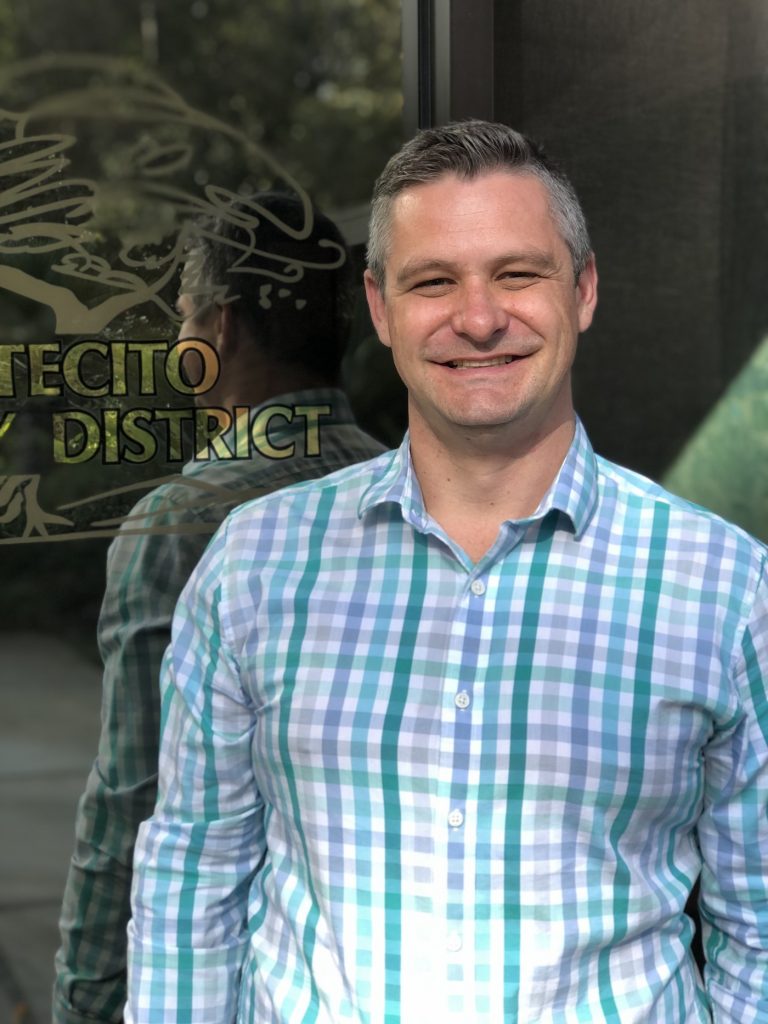Meet the GM at Montecito Sanitary District

The last five months have been busy for new Montecito Sanitary District General Manager Bradley Rahrer, who took the reins at the District in June of this year. Rahrer, who was hired after multiple interim managers came and went following the retirement of Diane Gabriel last year, hails from the city of Santa Barbara’s Public Works Department.
“I thought my career would be dealing with clean water for farming and irrigation rather than wastewater, but here I am!” Rahrer said during an interview earlier this week.
After graduating from Cal Poly with an undergraduate degree and two master’s degrees, Rahrer’s career in the water industry began in 2008 at a small irrigation district north of Davis, California. From there, he went on to work on larger water infrastructure projects at the Bureau of Reclamation Mid-Pacific Design and Construction office in Sacramento, eventually moving to Santa Barbara to continue working in the water industry and managing a team of 18. During his 10 years with the city of Santa Barbara, Rahrer worked as a Project Engineer on Wastewater Capital Improvement Projects, supported the city’s Wastewater Treatment Plant as the Operations and Maintenance Engineer, and managed a team responsible for the city’s network of sewer mains as the Wastewater Collection System Superintendent.
Rahrer’s arrival at the District comes after a proposed new Essential Services Building and associated improvements to the District campus have been put on the back burner indefinitely. The project, which is part of the District’s 2004 Master Plan, was to include a new 5,000-square-foot Essential Services building with a new 17-space parking lot, lighting and landscaping, multiple solar canopies, and a new recycled water treatment system, including a six-foot-high, 185-foot-long retaining wall to create a pad, a 60,000 gallon feed water tank, a 1,500-square-foot water treatment enclosure, a 130,000 gallon recycled water storage tank, and a 200-square-foot pump station, as well as demolition of the existing office building, existing solar canopies, and adjacent parking lot.
The new building was to replace the existing Essential Services building, which has long been considered undersized and has issues including mold, termites, asbestos, inadequate insulation, non-compliance with ADA requirements, and a leaking roof. The new building, which was controversial since its inception, was slated to be built on a different portion of the 6.3-acre campus, in order to abandon the access on Monte Cristo Lane and allow access on Channel Drive. The project cost was estimated between $4 million-$6 million.
Community opposition to the project ranged from frustration over the spending of District funds, to questioning the need for such a building, to frustrations over rate increases. Many members of the community, including those on the MSD’s own Board of Directors, suggested that the District, rather than building a new Essential Services Building, spend funds renovating the existing buildings and focusing on a recycled water program. Rahrer tells us recent improvements to the existing buildings include a new roof as well as plans to fully update the electrical systems on the site.
Had the large project come to fruition, the layout would have allowed for 36,000 square feet of space to be utilized for a future water recycling facility. Now, the District, in collaboration with Montecito Water District, is considering multiple options for recycled water, some of which would need the space on the Monte Cristo campus, and some which would not. The two Districts have currently commissioned the third study related to recycled water, which is expected to be complete in mid-to-late 2022.
Consultants are looking into four potential water reuse projects: one would be for irrigation purposes only (non-potable use); one would be in partnership with Carpinteria Sanitary District and Carpinteria Water District, and would require sending wastewater to Carpinteria; a third option would be to partner with the city of Santa Barbara for direct potable reuse; the last option is to create a facility for direct potable reuse within the District.
“We’re working closely with Montecito Water District’s general manager Nick Turner, as well as their Board of Directors, to bring this project to fruition. The two Districts have been collaborative and supportive,” Rahrer said.
A small pilot project on the MSD campus has been placed on standby, as the Board decides how to move forward.
“The project would give engineers more data on how to design a future water recycling plant, if we go in that direction,” Rahrer said.
In addition to progressing on a recycled water project, Rahrer says he is busy managing District infrastructure, including aging equipment and systems. One of the priorities of the Board is to convert septic systems in the District to sewer; there are roughly 330 parcels in the District that are run on septic. Rahrer also hopes to oversee a modernization of the management of the District.
“We’re lacking some of the modern processes and techniques that are available, some of which will predict infrastructure failure in order to extend useful life,” Rahrer said.
One example: installing “smart” manhole covers, which utilize ultrasonic sensors to detect problems in the sewer line.
Rahrer and his 18-person team are fairly new to the District, with longtime Operations Manager Alex Alonzo retiring earlier this year and Engineering Manager Carrie Poytress leaving the District for another job.
“Although the majority of the team is new, we’re fresh with new ideas, which I think is a good thing,” Rahrer said.
Current Board members include Board President Dorinne Lee Johnson, Vice President Woody Barrett, Secretary Dana Newquist, Treasurer Don Eversoll, and Director Gary Fuller.
“I’m excited to be here, and look forward to getting to know the Montecito community,” said Rahrer, who lives in Santa Barbara with his wife, Erin, and young son.
The District continues to be closed to the public due to the pandemic. Trailers on the property are allowing for support staff to keep socially distanced. To learn more about MSD, visit www.montsan.org.







You must be logged in to post a comment.